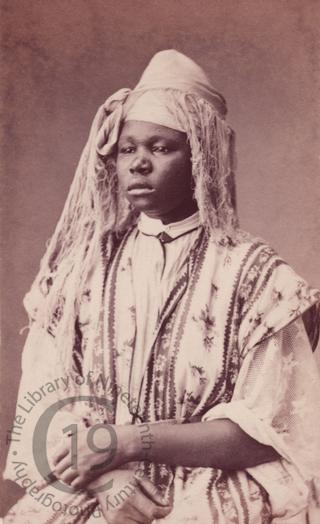
Algerian woman
Photographed by M. et Mme. Prud’hom of Bône in Algeria.
‘Jean Prud’hom and his wife, Camille, had a studio which had opened at least by 1864 at Bône in Algeria. One of their first and possibly only studio addresses was at 12 rue Caraman. They also appear to have had an additional studio or sales outlet at Constantinople during their early years in Algeria. They advertised that they specialised in “vues types indigenes” sometimes advertising “un très grand choix”.
‘A paucity of signed work from the studio makes it difficult to assess their overall output. Larger format Prod’hom views and portraits do not seem to have been generally signed in the negative nor stamped with a studio blindstamp, making identification difficult. … The few known works of Maison Prud’hom, particularly their native portraiture, are fine and created with great aplomb. Some show local groups posed against dramatic painted backdrops and with artificial studio props… despite the apparent artificiality of the setting, the group and single figure poses are beautifully realised.
‘The Prud’hom logo on c.1860’s-1870’s cartes de visite sometimes mentions ‘M. et Mme. Prud’hom et fils’, suggesting other family members may have been active in the firm from an early date. Camille Prud’hom qualifies as one of the earliest female photographers in North Africa, though Julie Geiser (if she was an active photographer) was, indeed, earlier. If, as is often suggested to be the case in Islamic countries, a woman was given the job of portraiture due to sensitivity on the part of female models to a male photographer, much credit goes to Camille Prud’hom for outstanding work. The Bône studio was still open in the mid-1890s.’
[The above paragraphs are taken from a longer, in-depth exploration of the studio’s history in Ken Jacobson’s Odalisques and Arabesques: Orientalist Photography 1839-1925 (Quaritch, 2007).
Code: 123906




